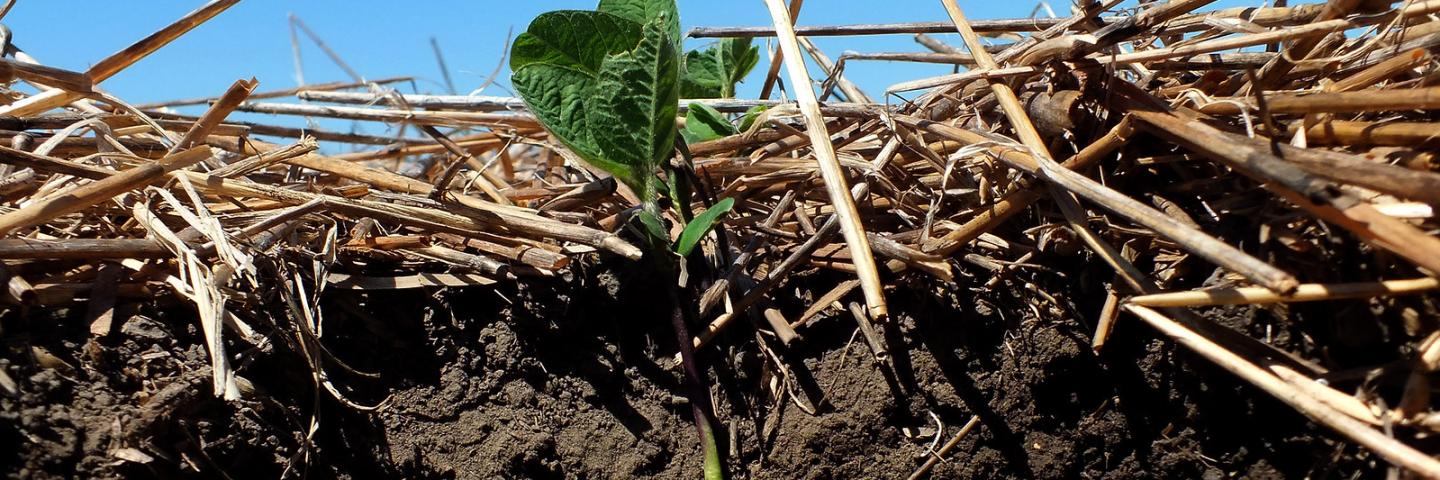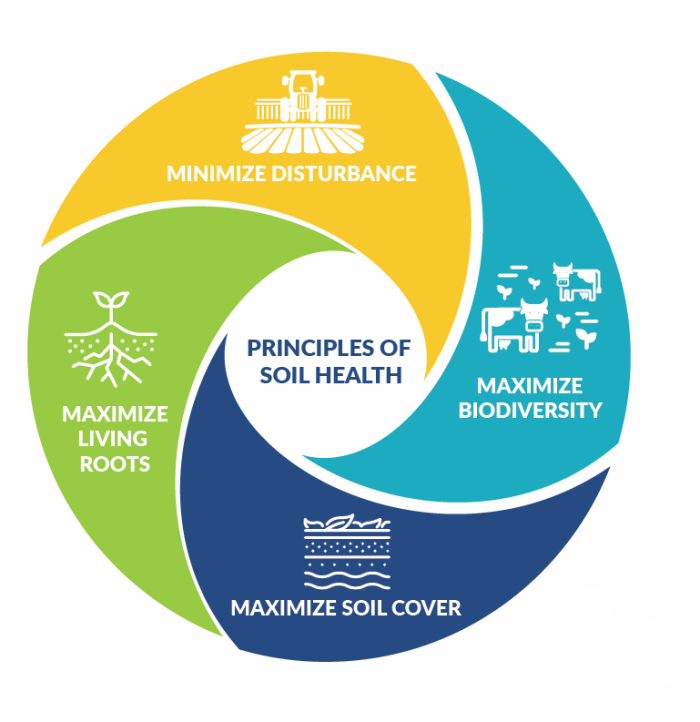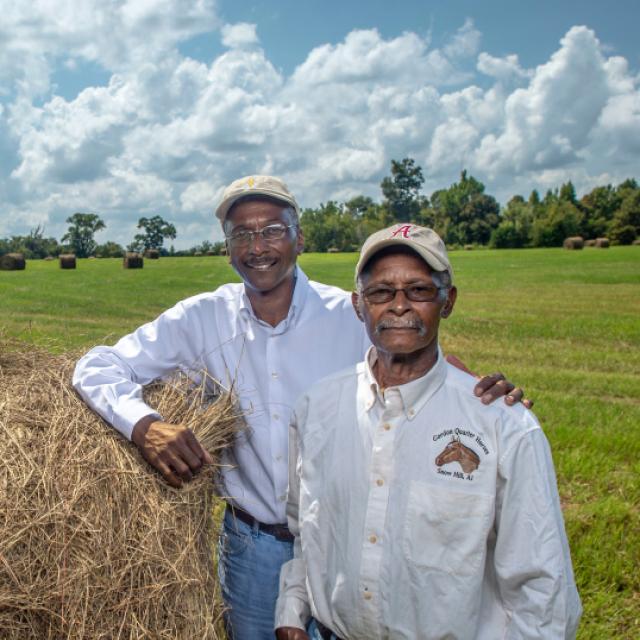
Success Story


Soil is not an inert growing medium – it is a living and life-giving natural resource. It is teaming with billions of bacteria, fungi, and other microbes that are the foundation of an elegant symbiotic ecosystem.
Soil health is defined as the continued capacity of soil to function as a vital living ecosystem that sustains plants, animals, and humans. Healthy soil gives us clean air and water, bountiful crops and forests, productive grazing lands, diverse wildlife, and beautiful landscapes. Soil does all this by performing five essential functions:

Soil health research has determined how to manage soil in a way that improves soil function.
As world population and food production demands rise, keeping our soil healthy and productive is of paramount importance. By farming using soil health principles and systems that include no-till, cover cropping, and diverse rotations, more and more farmers are increasing their soil’s organic matter and improving microbial activity. As a result, farmers are sequestering more carbon, increasing water infiltration, improving wildlife and pollinator habitat—all while harvesting better profits and often better yields.
Implementing Soil Health Management Systems can lead to increased organic matter, more diverse soil organisms, reduced soil compaction and improved nutrient storage and cycling. As an added bonus, fully functioning, healthy soils absorb and retain more water, making them less susceptible to runoff and erosion. This means more water will be available for crops when they need it.
Soil Health Management Systems allow farmers to enjoy profits over time because they spend less on fuel and energy while benefiting from less variable crop yields resulting from improved soil conditions. Healthy soils also provide a buffer for precipitation extremes (too wet or too dry).
Living plants maintain a rhizosphere, an area of concentrated microbial activity close to the root. The rhizosphere is the most active part of the soil ecosystem because it is where the most readily available food is, and where peak nutrient and water cycling occurs. Microbial food is exuded by plant roots to attract and feed microbes that provide nutrients (and other compounds) to the plant at the root-soil interface where the plants can take them up. Since living roots provide the easiest source of food for soil microbes, growing long-season crops or a cover crop following a short-season crop, feeds the foundation species of the soil food web as much as possible during the growing season.

Healthy soil is dependent upon how well the soil food web is fed. Providing plenty of easily accessible food to soil microbes helps them cycle nutrients that plants need to grow. Sugars from living plant roots, recently dead plant roots, crop residues, and soil organic matter all feed the many and varied members of the soil food web.
Tillage can destroy soil organic matter and structure along with the habitat that soil organisms need. Tillage, especially during warmer months, reduces water infiltration, increases runoff and can make the soil less productive. Tillage disrupts the soil’s natural biological cycles, damages the structure of the soil, and makes soil more susceptible to erosion.
The benefits of reduced till/no-till include:
Soil can also be disturbed through production inputs or improperly managed grazing practices. Inputs are not applied properly could potentially disrupt the delicate relationship between plants and soil organisms. Soil Health Management Systems help minimize potential disturbance, while maximizing nutrient cycling, which can lead to greater profitability for producers.

Improperly managed grazing can also harm the soil health system. There are several ways to graze livestock to reduce environmental impacts. For example, implementing a rotational grazing system instead of allowing livestock to continuously graze pasture allows pasture plants to rest and regrow.
Soil cover can be maximized by planting cover crops, annual crops, and perennial crops and leaving crop residues and living mulches on the ground. Soil health practices that maintain cover year-round improve soil health and protect soil from wind and water erosion.
Cover crops can be an integral part of a cropping system and provide soil cover during fallow seasons. Cover crops can be managed to improve soil health, as they help to develop an environment that sustains and nourishes plants, soil microbes and beneficial insects. The introduction of cover crops into your crop rotation can benefit any sized farm from a corn/soybean farm encompassing thousands of acres to a small urban farm.

Cover crops are typically planted in late summer or fall around harvest and before spring planting of the following year’s crops. Examples of cover crops include rye, wheat, oats, clovers and other legumes, turnips, radishes, and triticale. Planting several cover crop species together in a mixture can increase their impact on soil health. Each cover crop provides its own set of benefits, so it’s important to choose the right cover crop mixture to meet management goals.
The benefits of planting cover crops in between cash crop season include:
NRCS can help support you through the process of adding cover crops to your rotation by providing guidance for what cover crops to seed as well as how and when to seed with our guidance documents and site-specific planning worksheets. Financial assistance to help you start using cover crops is also available through the Environmental Quality Incentives Program (EQIP) and the Conservation Stewardship Program (CSP).
Biodiversity is the variation of life forms within a given ecosystem or field. The different life forms include all of the plants, animals and microorganisms. Increasing the diversity of a crop rotation and cover crops increases soil health and soil function, reduces input costs, and increases profitability.
For Soil Health Management Systems, biodiversity can be increased through a variety of approaches including: plant diversity through the use of diversified crop rotations, cover crop mixes, proper integration of grazing animals (e.g. livestock) into the system and includes animals living within the soils or microbial diversity, as well as direct additions with biological amendments. All four soil health management principles contribute to biodiversity.

Biodiversity helps to prevent disease and pest problems associated with monocultures. Using cover crops and increasing diversity within crop rotations improves soil health and soil function, reduces costs, and increases profitability. Diversity above ground improves diversity below ground, which helps create healthy productive soils.
Lack of biodiversity severely limits the potential of any cropping system and increases disease and pest problems. Biodiversity is ultimately the key to the success of any agricultural system. A diverse and fully functioning soil food web provides for nutrient, energy, and water cycling that allows a soil to express its full potential.
Soil health is an assessment of how well soil performs all of its functions now and how those functions are being preserved for future use.
Learn MoreLesson plans, educator guides, soil quality test kits, soil health posters, and other educational resources about soil health.
Learn MoreDig deep into soil health with these educational videos. Learn more about soil health practices and how they create a thriving ecosystem.
Learn MoreLiterature compiled from peer-reviewed papers relating to the impact of conservation practices on soil properties important for soil health.
Learn MoreThe Soil Health Division amplifies NRCS’ overall conservation planning and implementation efforts and adds conservation and economic value to the farming and ranching enterprises of NRCS’ customers through the integration of soil health.
Learn MoreDo you farm or ranch and want to make improvements to the land that you own or lease?
Natural Resources Conservation Service offers technical and financial assistance to help farmers, ranchers and forest landowners.

To get started with NRCS, we recommend you stop by your local NRCS field office. We’ll discuss your vision for your land.
NRCS provides landowners with free technical assistance, or advice, for their land. Common technical assistance includes: resource assessment, practice design and resource monitoring. Your conservation planner will help you determine if financial assistance is right for you.
We’ll walk you through the application process. To get started on applying for financial assistance, we’ll work with you:
Once complete, we’ll work with you on the application, or CPA 1200.
Applications for most programs are accepted on a continuous basis, but they’re considered for funding in different ranking periods. Be sure to ask your local NRCS district conservationist about the deadline for the ranking period to ensure you turn in your application in time.
As part of the application process, we’ll check to see if you are eligible. To do this, you’ll need to bring:
If you don’t have a farm number, you can get one from USDA’s Farm Service Agency. Typically, the local FSA office is located in the same building as the local NRCS office. You only need a farm number if you’re interested in financial assistance.
NRCS will take a look at the applications and rank them according to local resource concerns, the amount of conservation benefits the work will provide and the needs of applicants. View Application Ranking Dates by State.
If you’re selected, you can choose whether to sign the contract for the work to be done.
Once you sign the contract, you’ll be provided standards and specifications for completing the practice or practices, and then you will have a specified amount of time to implement. Once the work is implemented and inspected, you’ll be paid the rate of compensation for the work if it meets NRCS standards and specifications.